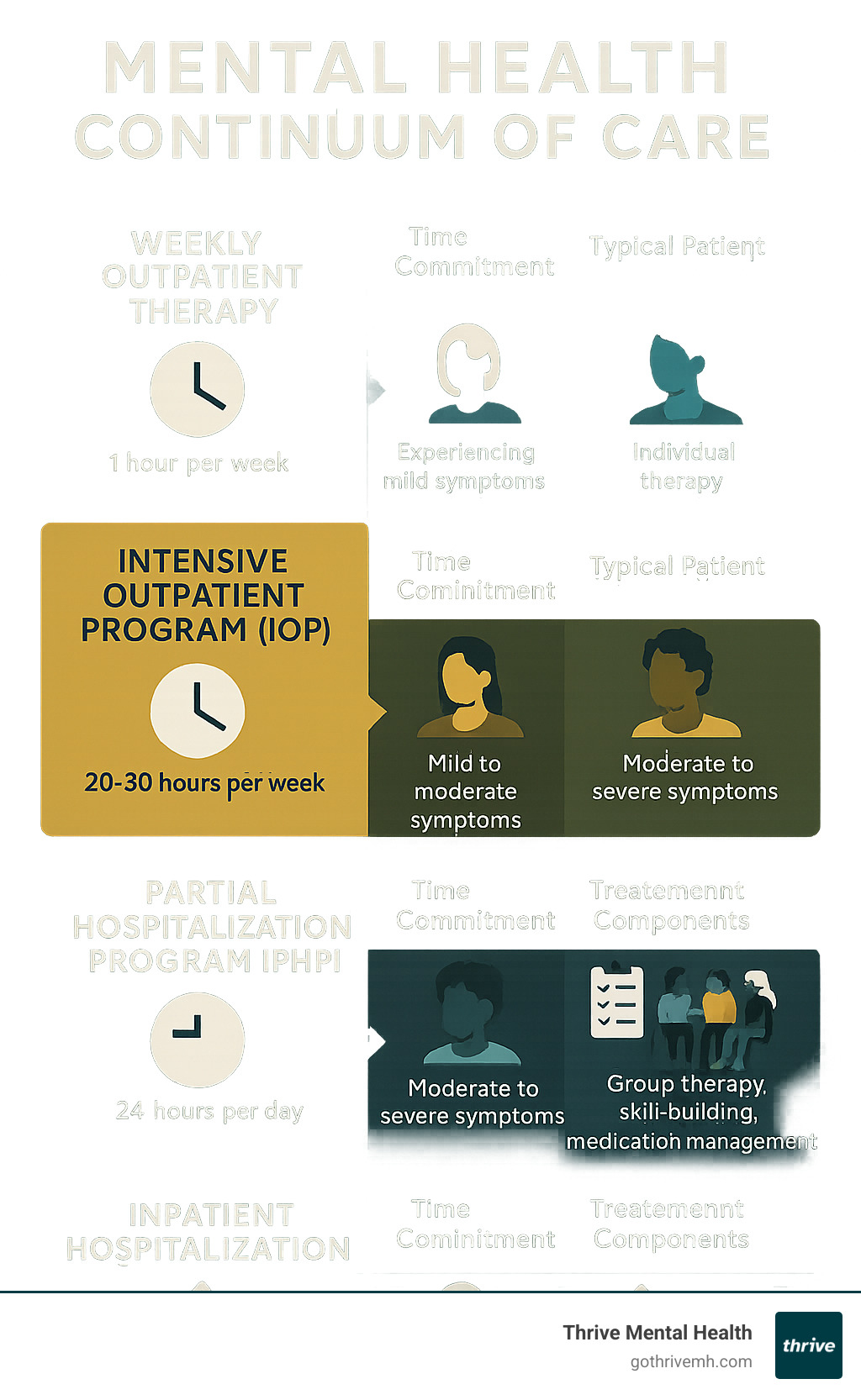PHP or IOP? Decoding Mental Health Treatment Options

Why Understanding Your Mental Health Treatment Options Matters
When facing mental health challenges, understanding iop vs php mental health treatment options can feel overwhelming, but it’s one of the most important decisions you’ll make for your recovery journey. More than one in five people in the United States is dealing with a mental health condition, yet many don’t know about the full spectrum of care available beyond weekly therapy sessions.
Quick Comparison: IOP vs PHP Mental Health Programs
| Feature | IOP (Intensive Outpatient) | PHP (Partial Hospitalization) |
|---|---|---|
| Time Commitment | 9-12 hours per week | 20-30 hours per week |
| Schedule | 3-5 days/week, 2-4 hours/day | 5-7 days/week, 4-6 hours/day |
| Duration | 8-16 weeks | 2-6 weeks |
| Flexibility | High – maintain work/school | Low – requires time off |
| Ideal For | Mild to moderate symptoms | Moderate to severe symptoms |
The mental health continuum of care offers structured treatment options that bridge the gap between traditional weekly therapy and inpatient hospitalization. Intensive Outpatient Programs (IOP) provide flexible, part-time treatment that allows you to maintain daily responsibilities, while Partial Hospitalization Programs (PHP) offer more intensive, full-day support without requiring an overnight stay.
Whether you’re a busy professional struggling to balance treatment with work demands, transitioning from higher levels of care, or finding that weekly therapy isn’t providing enough support, understanding these options empowers you to make the right choice for your unique situation.
As CEO of Thrive Mental Health, I’m Nate Raine, and I’ve dedicated my career to expanding access to innovative behavioral health solutions that address critical needs in mental wellness. My experience in developing comprehensive iop vs php mental health programs has shown me that the right level of care can make all the difference in achieving lasting recovery and maintaining the life balance you need.

Simple iop vs php mental health word guide:
Understanding the Programs: What Are IOP and PHP?

Picture this: you’re standing at a crossroads in your mental health journey, knowing you need more support than your weekly therapy session provides, but you’re not quite ready for—or don’t need—round-the-clock hospital care. This is exactly where understanding iop vs php mental health programs becomes crucial.
Both IOP and PHP are what we call levels of care in the mental health world. They’re structured therapy programs that fall perfectly between traditional outpatient therapy and inpatient hospitalization. Think of them as your safety net—intensive enough to provide real support, yet flexible enough to let you sleep in your own bed each night.
These outpatient services are specifically designed for people dealing with mental health disorders, substance use disorders, or both. The key difference? It’s all about how much structure and time commitment fits your current needs and life situation.
What is a Partial Hospitalization Program (PHP)?
A Partial Hospitalization Program is like having the intensive support of a hospital without actually staying overnight. It’s the highest level of care you can receive while still going home each evening—which is why many people call it “day treatment.”
PHP provides a structured environment with medical supervision, making it perfect if you’re stepping down from inpatient care or if your symptoms are severe enough that you need close monitoring. You’ll typically spend 20-30 hours per week in treatment, which means your days are pretty much dedicated to your recovery.
The beauty of PHP lies in its comprehensive approach. You’re not just talking through problems—you’re actively working on them in a safe, controlled setting with immediate access to psychiatric care if needed. It’s intensive, yes, but it’s also incredibly effective for people who need that level of support.
For more details about how PHP works in practice, check out our comprehensive PHP guide. You can also explore the clinical definition of partial hospitalization for additional background.
What is an Intensive Outpatient Program (IOP)?
If PHP is like having training wheels while learning to ride a bike, IOP is more like having a supportive friend running alongside you. It offers the perfect balance of flexibility and structure, allowing you to maintain your daily responsibilities while still getting intensive support.
IOP is often the sweet spot for busy professionals, students, or parents who can’t commit to full-day treatment but know they need more than weekly sessions. You might be stepping up from traditional therapy because you need extra support, or stepping down from PHP as you gain confidence in managing your mental health.
The focus here is on building real-world coping skills and developing solid relapse prevention strategies. You’ll attend sessions for about 9-12 hours per week, typically spread across three to five days. This schedule lets you practice what you learn in therapy while still living your regular life.
What makes IOP particularly powerful is how it bridges the gap between intensive treatment and everyday life. You’re learning to manage your mental health while actually living your life—going to work, caring for family, and handling daily stresses.
Learn more about how IOP can fit into your life with our detailed IOP overview. For additional context, the Wikipedia definition of IOP provides helpful background information.
IOP vs PHP Mental Health: A Detailed Comparison

When you’re weighing iop vs php mental health options, the details matter. Both programs offer structured support, but they’re designed for different needs and life situations. Think of it like choosing between a full-time intensive course versus a part-time program that fits around your existing commitments.
The key differences come down to treatment intensity, program structure, how they handle therapeutic modalities, their approach to co-occurring disorders, the level of family involvement, and considerations around cost and insurance. Let’s explore what this means for your recovery journey.
Intensity, Time Commitment, and Duration
The most obvious difference between these programs is how much of your week they require. PHP programs demand 20-30 hours per week – essentially a full-time commitment. You’ll typically attend five to seven days a week for four to six hours each day. This intensity means most people need to take time off work or arrange alternative childcare to participate fully.
IOP programs require 9-12 hours per week, usually spread across three to five days with sessions lasting two to four hours each. This schedule allows you to maintain your job, attend school, or care for family members while still receiving intensive support.
The duration also differs significantly. PHP programs typically run for 2-6 weeks, focusing on rapid stabilization when you’re in crisis or stepping down from inpatient care. IOP programs last 8-16 weeks, giving you time to build sustainable coping skills and practice them in real-world situations.
This difference in flexibility for work and school is often the deciding factor. If you’re a young professional who can’t take extended time off, IOP might be your path forward. If you’re in crisis and need immediate, intensive support, PHP provides that safety net.
Program Structure and Therapeutic Services
Both programs use evidence-based treatments, but they deliver them differently. Individual therapy sessions in PHP programs happen more frequently – sometimes daily – while IOP typically includes weekly individual sessions alongside group work.
Group therapy forms the backbone of both programs, and research shows it’s remarkably effective for many mental health conditions. In PHP, you might have multiple group sessions daily covering different topics, while IOP groups meet several times per week with consistent participants.
Family therapy and family involvement tend to be more structured in PHP programs, where there’s time for regular family sessions. IOP programs often include family components but may rely more on homework assignments and scheduled family meetings.
| Feature | IOP (Intensive Outpatient) | PHP (Partial Hospitalization) |
|---|---|---|
| Time Commitment | 9-12 hours/week | 20-30 hours/week |
| Ideal Candidate | Mild to moderate symptoms, strong support | Moderate to severe symptoms, needs structure |
| Therapies Offered | Group, individual, family (weekly) | Daily group, frequent individual, structured family |
| Medical Supervision | Regular check-ins, medication management | Daily monitoring, psychiatric oversight |
| Cost | Lower weekly cost, longer duration | Higher weekly cost, shorter duration |
Medication management is available in both programs, but PHP offers more frequent psychiatric oversight. If you’re adjusting medications or dealing with complex psychiatric needs, this closer medical supervision can be crucial.
Both programs incorporate evidence-based therapies like Cognitive Behavioral Therapy (CBT) and Dialectical Behavior Therapy (DBT). PHP programs can dive deeper into intensive DBT skills groups, while IOP programs focus on applying these skills in your daily environment.
Life skills training appears in both formats, but IOP programs excel at helping you practice these skills in real-time as you steer work, relationships, and daily stressors.
Addressing Co-Occurring Disorders and Dual Diagnosis
When you’re dealing with both mental health conditions and substance use issues, both IOP and PHP programs can provide integrated treatment approaches. The SAMHSA guidelines on co-occurring disorders emphasize treating both conditions simultaneously rather than separately.
PHP programs often provide more intensive specialized care for complex dual diagnosis situations. If you’re stepping down from inpatient treatment for both substance use disorder (SUD) and mental health conditions, the structured environment and daily support can be essential.
IOP programs excel when you have a stable living situation and strong support system but need ongoing intensive support for co-occurring disorders. The flexibility allows you to attend support group meetings, maintain employment, and practice recovery skills in real-world settings.
For those interested in flexible options, our telehealth outpatient programs can provide specialized dual diagnosis care regardless of your location in Florida.
Cost and Insurance Coverage
Understanding the financial aspects of PHP cost vs. IOP cost helps you plan effectively. PHP programs typically have higher weekly costs due to their intensity, but shorter duration. IOP programs cost less per week but run longer, so total costs can vary significantly.
Insurance verification is crucial for both programs. Most major insurance plans cover both IOP and PHP when medically necessary, but pre-authorization requirements differ. PHP programs often require more extensive documentation due to their intensive nature.
Out-of-pocket expenses vary based on your specific insurance plan and whether your provider is in-network vs. out-of-network. Many programs, including ours at Thrive Mental Health, offer financial assistance options and payment plans to make treatment accessible.
The key is working with your treatment team to understand what your insurance covers and exploring all available options to make your chosen program financially manageable.